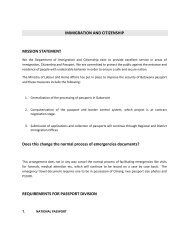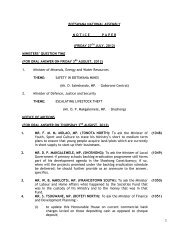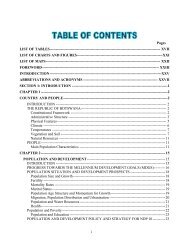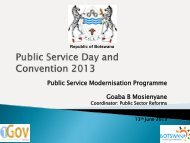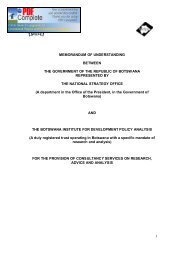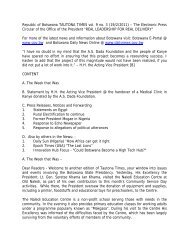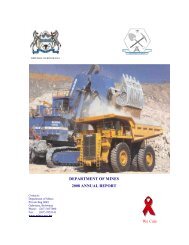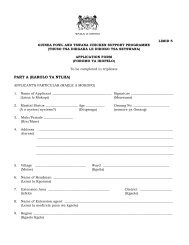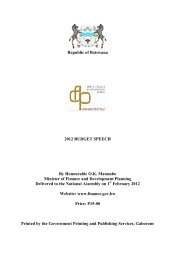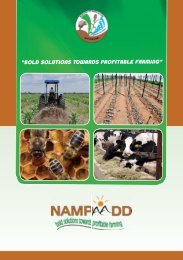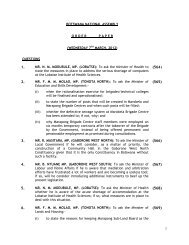Roads Department - Government of Botswana
Roads Department - Government of Botswana
Roads Department - Government of Botswana
Create successful ePaper yourself
Turn your PDF publications into a flip-book with our unique Google optimized e-Paper software.
<strong>Roads</strong> <strong>Department</strong><br />
7. SUMMARY<br />
In the semi-arid climate <strong>of</strong> <strong>Botswana</strong> evaporation exceeds precipitation, soluble<br />
salts accumulate in the upper layers <strong>of</strong> the road pavement and can damage<br />
bituminous surfacings such as prime coats and surface dressings.<br />
Single salt blister, exposing the base layer.<br />
Studies have identified the importance <strong>of</strong> climatic factors and intervals between<br />
the construction <strong>of</strong> each pavement layer, surfacing types and trafficking. The<br />
design procedure show that single values <strong>of</strong> salt limits, as suggested in other<br />
reports, are not appropriate for all surfacing types and construction procedures.<br />
A procedure for risk evaluation <strong>of</strong> potential salt damage has been developed<br />
based on the laboratory and field trials in <strong>Botswana</strong>. Risk ratings are assessed<br />
for materials, compaction and ground water, and climatic conditions for different<br />
surfacing types.<br />
Bituminous prime coats are very sensitive to salt damage and can be damaged<br />
if the soluble salt content exceeds 0.3% TDS in the road base material as a<br />
whole. Cutback prime is more sensitive to damage than emulsion prime.<br />
Salt dome, which will breake under traffi c and<br />
- resulting in an exposed base.<br />
Surface dressings and Otta seals are more resistant than bitumen primes to<br />
salt damage due to their increased bitumen thickness. In <strong>Botswana</strong> trafficked<br />
single and double surface dressings will generally not be damaged by roadbase<br />
TDS contents up to 0.5% and 1.0% respectively. Trafficking appears to<br />
increase the resistance <strong>of</strong> surface dressing to salt damage. Surface sealed road<br />
shoulders and large areas <strong>of</strong> runway are especially vulnerable to salt attack at<br />
lower salt content levels.<br />
For salt levels at the upper acceptable limits, a prime coat should preferably<br />
be excluded where other engineering considerations, such as adhesion to roadbase,<br />
allows. Alternatively, the prime coat could be surface dressed within two<br />
days <strong>of</strong> application but this is sometimes impractical in contract situations.<br />
Interestingly, on withdrawal <strong>of</strong> traffic from hitherto sound sections, the surfacing<br />
became damaged.<br />
When the subgrade is saline and pavement layers comprise non saline materials,<br />
impermeable fabric (plastic) placed at the bottom <strong>of</strong> the roadbase prevents<br />
upward rise <strong>of</strong> salt and protects the bituminous surfacing from salt damage.<br />
If placed with care, drainage and long term performance is not compromised.<br />
A thick bitumen layer placed in the same position has not been successful in<br />
this respect. The technique <strong>of</strong> a cut-<strong>of</strong>f membrane has been applied to roads<br />
in <strong>Botswana</strong>.<br />
38 Chapter 7<br />
Guide to the Prevention and Repair <strong>of</strong> Salt Damage to <strong>Roads</strong> and Runways<br />
Summary



